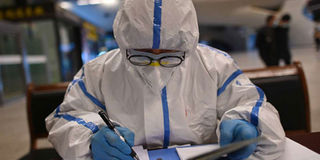Premium
Scientific ways to fight COVID-19: What works, what doesn’t

What you need to know:
- Dr Tedros advised that Kenya trains and deploys healthcare workers.
- Studies show that when unchecked, the R0 of Covid-19 is between 2 and 3.
- If there are too many sick people in hospital, it will overwhelm the healthcare system.
During an update last week, Maria Van Kerkhove, who is the head of the World Health Organisation (WHO’s) emerging diseases and zoonosis, termed numbers the mathematical models used to predict how Covid-19 will progress in Kenya as “quite scary”.
That is also the very week when Cabinet Secretary for Health Mutahi Kagwe announced that Kenya had hit the 30th mark for patients who had tested positive for the virus.
WHO Director-General Tedros Adhanom says it is a good thing that Kenya has not hit the 100th mark, because using six measures, the country can suppress the disease once and for all.
HEALTH WORKERS
First, Dr Tedros advised that Kenya trains and deploys healthcare workers.
Luckily, with the help of the Africa CDC and WHO, Kenya has trained nurses, clinical officers and doctors on responding to Covid-19.
Dr Tedros also encouraged the preparation for isolation centres as well as a mechanism for tracing especially at the community level.
The most challenging of the six steps, and perhaps where our success lies, is “suppressing and controlling Covid-19”.
Suppression is a medical term which refers to the efforts to reduce the infectivity of a pandemic. Those in the field of tracking diseases (epidemiology) call this infectivity R0, pronounced R-naught. The desire of the Ministry of Health is to reduce the R0 to less than one.
UNCHECKED R0
Studies that have been carried out in Wuhan, China and other places that have suffered from the disease show that when unchecked, the R0 of Covid-19 is between 2 and 3, meaning that every infected person infects, two to three others.
An R0 less than 1 indicates that each infected person results in less than one new infection. When this happens, the outbreak will slowly grind to a halt.
Suppression, while very effective as was seen in Singapore, is very expensive. It would mean that the government tests as many people as possible, with or without symptoms, and then when one is found positive, they isolate the individual so that he or she does not infect other people.
KEYS TO SUCCESS
“Further keys to success would be a large, well-organised testing programme, combined with extensive efforts to isolate infected people and trace and quarantine their contacts as seen in Singapore and in South Korea,” said Dr Marianne Mureithi, the acting chairperson of the Department of Medical Microbiology at the College of Health Sciences in the University of Nairobi.
However, this has not been possible because Kenya’s health system cannot test many people.
Kenya’s best option has been social distancing, asking people to stay away from groups and away from each other. The Centres for Disease Control and Prevention recommended it as one of the methods to limit the spread of Covid-19 at the community level.
ASYMPTOMATIC
This could not be more important when studies are showing that in the preclinical phase, people who are asymptomatic – those who do not present any signs of the disease — can spread it through viral shedding, that is, through coughing and sneezing.
A German study that was uploaded online in March 8, 2020 showed that throat swabs of people with little or no symptoms had high levels of the virus that causes the disease SARS-CoV-2.
Three other studies, including another published in the prestigious New England Journal of Medicine wrote: “The viral load that was detected in the asymptomatic patient was similar to that in the symptomatic patients, which suggests the transmission potential of asymptomatic or minimally symptomatic patients”
SLOW DOWN INFECTIONS
So, social distancing is temporising, to slow down the infections and buy time for the government to treat those who are already sick.
If there are too many sick people in hospital, it will overwhelm the healthcare system.
We do not have those many nurses, doctors and clinical officers even when there are no pandemics. There are also not that many intensive care unit beds should it come to that point. Also, it is not like healthcare workers have stopped attending to the usual accidents, obstetrics.
In social distancing, people are encouraged to wash their hands with soap or alcohol sanitisers. Coronaviruses are vulnerable to and easily destroyed by soap as well as alcohol. The particle has a collection of genes which are surrounded by fatty lipid molecules. Lipids are, by nature, destroyed by soap.
CHALLENGES
Medical anthropologist, Prof Salome Bukachi from the University of Nairobi, says that there may be a challenge with implementing social distancing because while this is the proper public health strategy, people in informal settlements may not adhere to the recommendation for reasons beyond their control.
According to the Kenya Demographic Health Survey, nearly one third (29 per cent) of the population do not have access to clean drinking water.
Then there is fear that has been fuelled by social media. Social distancing involves self-quarantine.
Dr Mary Amuyunzu-Nyamongo, an expert in social anthropology, warned that the scathing condemnation of those who failed to follow the government directive to self-quarantine will discourage others to come out.
She added that social media did not help either, even among the educated.
"There are so many jokes and memes on social media that downplay the severity of the issue,” she said.





